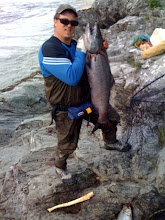
The Alaska Mary Ann
The Alaska Mary Ann is one of my first ventures into the tying of classic flies. I will never fish with this one, it is meant for display only. I cut the tail hackle a bit short, but it is still a beautiful fly none the less. The following is the text from from the Alaska Flyfishers (AFF) book, ‘Fly Patterns of Alaska,’ published by Frank Amato Publications.
“This is the official fly of the Alaska Flyfishers. It was developed by Frank Dufresne, and several versions of the story about it’s origin exist. Even Dufresne himself has been reported to have told different stories on different occasions. For many years Eskimo women in the Kotzebue area have used a small jig, called the ‘Kobuk Hook,’ to jig for char and sheefish through the ice. It is made from a sliver of ivory, a bent and sharpened nail, and some polar bear hair. Dufresne tried them on a fly rod and found them very effective. When he ran out of the originals, he tied a duplicate using regular fly tying materials.
According to one story, the fly was named for the Eskimo lady who gave Dufresne the ‘Kobuk Hooks' and whose name was Mary Ann. This version was shown to club member Harry Geron in 1953 at Sparrevohn Air force Station by a man who claimed to have been a friend of Dufresne, who showed him how to tie it and told him it’s history. For many years this has been a good pattern for virtually all predatory fish in Alaskan rivers and lakes.”
From that we now go to a reference by H.H. Smedley. The source is ‘Fly Patterns and Their Origins,’ published in 1950 by Westshore Publications, Muskegon, Michigan. Again, I will take the text directly from the pages of the book.
“This pattern was conceived and perfected by Frank Dufresne, whose name and fame are known throughout Alaska. From southeastern Alaska to the Arctic he has fished, guided, explored and carried on his work as a naturalist for twenty odd years. During much of that time he worked in the official capacity as Fish and Game Commissioner and later with the United States Fish and Wildlife service. He is the author of ‘Alaska Animals and Fishes.’
On the Kobuk River, north of Nome, in the summer of 1922 he saw the natives there fishing with an artificial bait. It was made of ivory and shaped not unlike a small modern lure. The copper hook, not barbed, had attached to it a small triangular piece of red skin from the corner of a guillenot’s bill, a black eye made from whale bone was inserted at the forward end of the piece of ivory and a sparse topping of white polar bear hair was attached.
In 1929 Dufresne, for fly fishing, reproduced the lure in hair and feathers. A silver tinsel body, red tag, jungle cock eye and polar bear wing on a long shank hook and the Alaska Mary Ann came into being.
The name Mary Ann in Alaska is used to describe or refer to a girl whose name might not be known. It is an expression, used much the same as ‘baby doll’ was used, some years ago.”

No comments:
Post a Comment